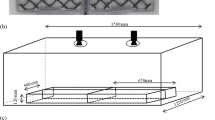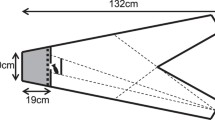Abstract
Animals pay opportunity costs when pursuing one of several mutually exclusive courses of action. We quantified the opportunity costs of conforming to the behaviour of others in foraging sticklebacks (Pungitius pungitius), using an arena in which they were given the option of shoaling in one area or searching for food in another. Fish foraging in the absence of stimulus conspecifics found the prey patch sooner and spent longer exploiting it than those in trials where a stimulus shoal was present. Furthermore, in trials where the stimulus shoal exhibited feeding cues, subjects approached them sooner and spent more time shoaling with them, exploring less of the arena than in trials where the stimulus shoal exhibited no such cues. This suggests sensitivity not only to the mere presence of conspecifics, but also to the social information that they produce. We also saw that groups of focal fish, compared to single individuals, were less influenced by the stimulus shoal and explored more of the arena, a behaviour that may be attributed to facilitation, competition or both. Such opportunity costs are likely to be offset by benefits such as reduced predation risk, and we discuss this in terms of the trade-offs associated with living in groups.






Similar content being viewed by others
References
Ballerini M, Calbibbo N, Candeleir R, Cavagna A, Cisbani E, Giardina I, Lecomte V, Orlandi A, Parisi G, Procaccini A, Viale M, Zdravkovic V (2008) Interaction ruling animal collective behavior depends on topological rather than metric distance: evidence from a field study. P Natl Acad Sci USA 105:1232–1237
Baron RS, Vandello JA, Brunsman B (1996) The forgotten variable in conformity research: the impact of task importance on social influence. J Pers Soc Psychol 71:915–927
Boyd R, Richerson PJ (1985) Culture and the evolutionary process. University of Chicago Press, Chicago
Briggs SE, Godin J-GJ, Dugatkin LA (1996) Mate choice copying under predation risk in the Trinidadian guppy (Poecilia reticulata). Behav Ecol 7:151–157
Buckingham JN, Wong BBN, Rosenthal GG (2007) Shoaling decisions in female swordtails: how do fish gauge group size? Behaviour 144:1333–1346
Coolen I, van Bergen Y, Day RL, Laland KN (2003) Species difference in adaptive use of public information in sticklebacks. P Roy Soc Lond B 270:2413–2419
Coolen I, Ward AJW, Hart PJB, Laland KN (2005) Foraging nine-spined sticklebacks prefer to rely on public information over simpler social cues. Behav Ecol 16:865–870
Coussi-Korbel S, Fragaszy DM (1995) On the relation between social dynamics and social learning. Anim Behav 50:1441–1453
Couzin ID, Krause J, James R, Ruxton GD, Franks NR (2002) Collective memory and spatial sorting in animal groups. J Theor Biol 218:1–11
Crawley MJ (2007) The R book. Wiley, Chichester
Day RL, Macdonald T, Brown C, Laland KN, Reader SM (2001) Interactions between shoal size and conformity in guppy social foraging. Anim Behav 62:917–925
Feldman M, Aoki K, Kumm J (1996) Individual versus social learning: evolutionary analysis in a fluctuating environment. Anthropol Sci 104:209–231
Galef BG (2009) Strategies for social learning: tests of predictions from formal theory. Adv Stud Behav 39:117–151
Galef BG, Whiskin EE (2006) Increased reliance on socially acquired information while foraging if in risky situations. Anim Behav 72:1169–1176
Giraldeau LA, Caraco T (2000) Social foraging theory. Princeton University Press, Princeton
Gonda A, Herczeg G, Merilä J (2009) Habitat-dependent and -independent plastic responses to social environment in the ninespine stickleback (Pungitius pungitius) brain. P Roy Soc Lond B 276:2085–2092
Grand TC, Dill LM (1999) The effect of group size on the foraging behaviour of juvenile coho salmon: reduction of predation risk or increased competition? Anim Behav 58:443–451
Hager MC, Helfman GS (1991) Safety in numbers: shoal choice by minnows under predatory threat. Behav Ecol Sociobiol 29:271–276
Harcourt JL, Biau S, Johnstone R, Manica A (2010) Boldness and information use in three-spined sticklebacks. Ethology 116:440–447
Herczeg G, Gonda A, Merilä J (2009) The social cost of shoaling covaries with predation risk in ninespine stickleback, Pungitius pungitius, populations. Anim Behav 77:575–580
Hoare DJ, Couzin ID, Godin J-GJ, Krause J (2004) Context dependent group size choice in fish. Anim Behav 67:155–164
Hoskin RE (1983) Opportunity cost and behavior. J Acc Res 21:78–95
Kendal RL, Coolen I, van Bergen Y, Laland KN (2005) Trade-offs in the adaptive use of social and asocial learning. Adv Stud Behav 35:333–379
Kendal JR, Rendell L, Pike TW, Laland KN (2009) Nine-spined sticklebacks deploy a hill-climbing social learning strategy. Behav Ecol 20:238–244
Krause J, Ruxton GD (2002) Living in groups. Oxford University Press, Oxford
Kurvers R, van Oers K, Nolet BA, Jonker RM, van Wieren SE, Prins HHT, Ydenberg RC (2010) Personality predicts the use of social information. Ecol Lett 13:829–837
Laland KN (2004) Social learning strategies. Learn Behav 32:4–14
Laland KN, Atton N, Webster MM (2011) From fish to fashion: experimental and theoretical insights into the evolution of culture. Philos T R Soc B 366:958–968
Mashoodh R, Sinal CJ, Perrot-Sinal TS (2009) Predation threat exerts specific effects on rat maternal behaviour and anxiety-related behaviour of male and female offspring. Physiol Behav 96:693–702
Morgan MJ, Colgan PW (1987) The effects of predator presence and shoal size on foraging in bluntnose minnows, Phoxinus notatus. Environ Biol Fish 20:105–111
Pike TW, Kendal JR, Rendell L, Laland KN (2010) Learning by proportional observation in a species of fish. Behav Ecol 21:570–575
Pike TW, Laland KN (2010) Conformist learning in nine-spined sticklebacks’ foraging decisions. Biol Lett 6:466–468
Pitcher TJ, Magurran AE, Winfield IJ (1982) Fish in larger shoals find food faster. Behav Ecol Sociobiol 10:149–151
Pitcher TJ, Misund OA, Ferno A, Totland B, Melle V (1996) Adaptive behaviour of herring schools in the Norwegian Sea as revealed by high-resolution sonar. ICES J Mar Sci 53:449–452
Reale D, Reader SM, Sol D, McDougall PT, Dingemanse NJ (2007) Integrating animal temperament within ecology and evolution. Biol Rev 82:291–318
Rendell L, Boyd R, Cownden D, Enquist M, Eriksson K, Feldman MW, Fogarty L, Ghirlanda S, Lillicrap T, Laland KN (2010) Why copy others? Insights from the social learning strategies tournament. Science 328:208–213
Rendell L, Fogarty L, Hoppitt WJE, Morgan TJH, Webster MM, Laland KN (2011) Cognitive culture: theoretical and empirical insights into social learning strategies. Trends Cogn Sci 15:68–76
Rieucau G, Giraldeau LA (2009) Persuasive companions can be wrong: the use of misleading social information in nutmeg mannikins. Behav Ecol 20:1217–1222
Uryu Y, Iwasaki K, Hinoue M (1996) Laboratory experiments on behaviour and movement of a freshwater mussel, Limnoperna fortunei (Dunker). J Mollus Stud 62:327–341
Ward AJW (2011) Social facilitation of exploration in mosquitofish (Gambusia holbrooki). Behav Ecol Sociobiol In Press: DOI: 10.1007/s00265-011-1270-7
Ward AJW, Herbert-Read JE, Sumpter DTJ, Krause J (2011) Fast and accurate decisions through collective vigilance in fish shoals. P Natl Acad Sci USA 109:2312–1315
Webster MM, Hart PJB (2004) Substrate discrimination and preference in foraging fish. Anim Behav 68:1071–1077
Webster MM, Hart PJB (2006) Subhabitat selection by foraging threespine stickleback (Gasterosteus aculeatus): previous experience and social conformity. Behav Ecol Sociobiol 60:77–86
Webster MM, Goldsmith J, Ward AJW, Hart PJB (2007a) Habitat specific chemical cues influence association preferences and shoal cohesion in fish. Behav Ecol Sociobiol 62:273–280
Webster MM, Ward AJW, Hart PJB (2007b) Boldness is influenced by social context in threespine sticklebacks (Gasterosteus aculeatus). Behaviour 144:351–371
Webster MM, Laland KN (2008) Social learning strategies and predation risk: minnows copy only when using private information would be costly. P Roy Soc Lond B 275:2869–2876
Webster MM, Laland KN (2011) Reproductive state affects reliance on public information in sticklebacks. P Roy Soc Lond B 278:619–627
Webster MM, Ward AJW (2011) Personality and social context. Biol Rev 86:759–773
Acknowledgements
This work was funded by a European Research Council advanced grant (EVOCULTURE 232823) to KNL. We thank Ashley Ward for helpful discussion.
Ethical standards
The experiments described in the article were performed in accordance with the current laws of the UK.
Author information
Authors and Affiliations
Corresponding author
Additional information
Communicated by J. Krause
Rights and permissions
About this article
Cite this article
Webster, M.M., Laland, K.N. Social information, conformity and the opportunity costs paid by foraging fish. Behav Ecol Sociobiol 66, 797–809 (2012). https://doi.org/10.1007/s00265-012-1328-1
Received:
Revised:
Accepted:
Published:
Issue Date:
DOI: https://doi.org/10.1007/s00265-012-1328-1




